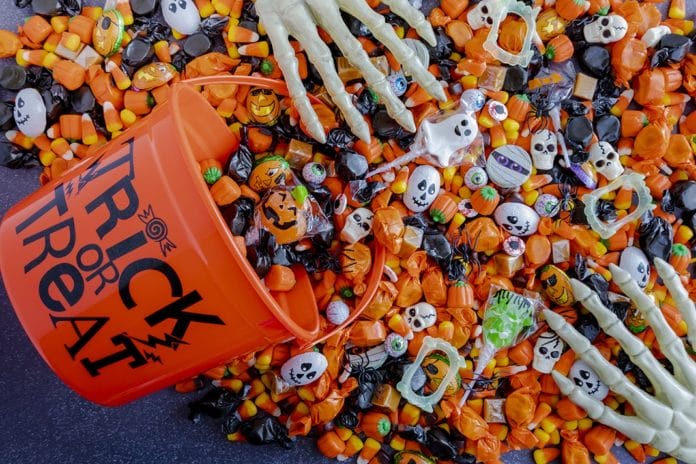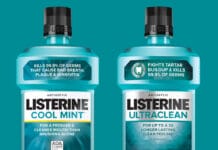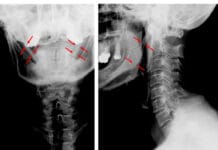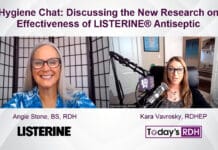On October 31st, dental professionals cringe every time the candy lands in the bucket after our kids shout out the expected “Trick-or-Treat!” Once our little ghouls come home with a full bucket of “treats,” the “trick” is keeping their mouths cavity-free.
Dental caries among children from ages six through eleven affects up to 21 percent of the U.S. population.1 The production of dental caries is the result of sugar and acid introduction to the oral cavity. Therefore, understanding the etiology of dental caries and prevention aids is important, not only for parental dental professionals but for feedback to our patients and their parents as well.
Disconcertingly, a 2016 study reported that over $2 billion are spent on candies during the Halloween season alone, resulting in the average trick-or-treater consuming roughly three cups of sugar.2 Consequently, using the mnemonic “TREAT” as a guide to prevention of caries for the dental professional or parents will help to ensure healthy mouths and happy trick-or-treaters.
Teach
Teach the parents about dental caries. Dental caries relies on an acidic environment to promote demineralization. The production of acid is introduced by the consumption of an acidic or sugary product. Once the sugar is introduced to the oral cavity it is then converted to an acid by the bacteria present.
Rinse
Rinsing the oral cavity after the consumption of candy can aid in neutralizing the acidic environment. The International Journal of Drug Testing reports that normal pH levels to maintain a neutral environment ranges from 5.6 to 7.9.3 Also, rinsing with a fluoridated rinse can protect the enamel and aid in remineralizing any area compromised by the acidic environment.
Exposure
The duration of candy exposure to the oral cavity plays a role in the risk of caries production. Therefore, candy choice is important in eliminating a caries threat. Lollipops and hard candies particularly come to mind when discussing exposure. Unlike a chocolate bar that is consumed in minutes, a lollipop or hard candy will slowly dissolve over time, increasing the duration of sugar and acid exposure. This makes it particularly difficult for the pH levels of the saliva to reset and aid in neutralizing the oral environment.
Acid
Candies containing citric or malic acid plays a role in the breakdown and demineralization of the enamel surface of the tooth due to their low pH compounds.4 The introduction of these acidic candies can be irreparable if the exposure is consistent.
Too sticky
Lastly, sticky candies such as gummies, caramels, nougats, or hard candies increase the exposure time of the sugars and acids to the oral environment by becoming entrapped on the tooth surface. The gelatins, sugars, syrups, and acid contents of these candies break down the enamel surface by decreasing the salivary pH, thus promoting carious bacteria activity.
Some alternative choices when choosing a treat are chocolates, sugarless products containing xylitol, or replacing the candy with money or gifts. Chocolate may be a better candy choice since it is consumed faster, clears the mouth quickly, and may contain “cocoa,” which displays antibacterial properties against streptococci mutans, a caries-producing bacteria.5
Xylitol is a natural sugar alcohol that cannot be broken down or metabolized by bacteria. As a result, it degrades the presence of the caries-causing bacteria.6 Xylitol is most often found in sugarless gums and hard candies. (Note: keep xylitol-containing products away from pets. For some, xylitol can cause stomach upset.)
Lastly, alternatives to candy consumption such as candy buy-backs or replacing Halloween candy with a toy will positively ensure a healthy mouth.
Although no parent, even a dedicated dental professional, wants to play the “Big Bad Wolf” by refusing the child their Halloween treats, understanding the right choices and alternatives can aid in caries prevention.
Now Listen to the Today’s RDH Dental Hygiene Podcast Below:
References
- The State of Little Teeth: Second Edition. American Academy of Pediatric Dentistry. Retrieved from http://mouthmonsters.mychildrensteeth.org/the-state-of-little-teeth-second-edition.
- Karwoski & Courage. Halloween Candy Consumption. 25 October 2016. Retrieved from http://creativepr.com/halloween-candy-consumption-infographic/.
- Gupta, S. What is pH of saliva? Retrieved from www.livestrong.com/article/192281-what-is-ph-of-saliva
- Definition of Citric Acid, Definition of Malic Acid. Wikipedia. Retrieved from www.wikipedia.com
- Sudharsana, A., Dorai kannan, Sri sakthi. (2014). Tooth friendly chocolate. Journal of Pharmaceutical Sciences and Research. 7. 49-50.
- Sudharsana, A., Srisakthi, S. Tooth Friendly Chocolate. Journal. 2015; 17(1): 49-51. Retrieved from https://www.jpsr.pharmainfo.in/Documents/volumes/vol17Issue01/jpsr07011510.pdf
- Xylitol: The decay preventative sweetener. California Dental Association. 2017. Retrieved from https://www.cda.org/Portals/0/pdfs/fact_sheets/xylitol_english.pdf










